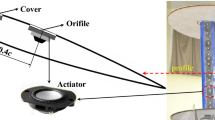Abstract
In this paper, a numerical investigation of airfoil flow control using passive air jet is presented. The study of generate a passive jet from pressure side to suction side was conducted in order to improve the airfoil characteristics. Such characteristics include boundary layer separation and stall inception. The numerical simulations conducted using CFDRC software. Different structured and unstructured finite volume technique is used to solve the steady compressible Navier—Stokes equations. The code results were validated with the experimental testing results for different turbulence model. Parametric study is performed for the location, slot width and angle of a synthetic jet on the suction side of a subsonic flow over a NACA 23012C airfoil. The maximum lift is achieved with the jet flow being normal to suction side surface but this come with penalty of the high drag. The maximum lift to drag ratio was accompanying with synthetic jet being located at 43% chord and 30° jet angle. Finally, optimum geometry of jet is obtained using simplex algorithm with initial shape obtained from the parametric study.
Similar content being viewed by others
References
J. Gilarranz, L. Traub, and O. Rediniotis, Characterization of a compact, high-power synthetic jet actuator for flow separation control, in: 40th AIAA Aerospace Sciences Meeting and Exhibit, 14–17 January 2002, AIAA 2002–0127.
M. Bauer, I. Peltzer, W. Nitsche, and B. Gölling, Active flow control on an industry-relevant civil aircraft half model, Notes on Numerical Fluid Mechanics and Multidisciplinary Design, 2010, Volume 108/2010, 95–107, DOI: https://doi.org/10.1007/978-3-642-11735-07.
J.P. Bons, R. Sondergarrd, and R.B. Rivir, Turbine separation control using pulsed vortex generator jets, J. Turbomachinery, 2001, Vol. 123, P.198–206.
H. Shan, L. Jiang, C. Liu, M. Love, and B. Maines, Numerical study of passive and active flow separation control over a NACA 0012 airfoil, Comp. Fluids, 2008, Vol. 37, No. 8, P. 975–992.
Y.V. Pehlivanoglu and B. Yagiz, Optimization of active/passive flow control parameters on airfoils at transonic speeds, J. Aircraft, 2011, Vol. 48, No. 1, P. 212–219.
M. Asli, B.M. Gholamali, and A.M. Tousi, Numerical analysis of wind turbine airfoil aerodynamic performance with leading edge bump, Math. Problems Engng, 2015, P. 1–8. DOI: https://doi.org/10.1155/2015/493253.
H. Tebbiche and M.S. Boutoudj, Passive control on the NACA 4412 airfoil and effects on the lift, in: Design and Modeling of Mechanical Systems — II Lecture Notes in Mechanical Engineering, 2015, P. 775–781.
K. Yousefi and R. Saleh, Three-dimensional suction flow control and suction jet length optimization of NACA 0012 wing, Meccanica, 2015, Vol. 50, No. 6, P. 1481–1494.
D.P. Jansen, Passive Flow Separation Control on an Airfoil-Flap Model, Master of Science Thesis, Delft University of Technology, 2012.
M. Alam and N.D. Sandham, Direct numerical simulation of “short” laminar separation bubbles with turbulent reattachment, J. Fluid Mech., 2000, Vol. 410, P. 1–28.
M. Gad-el Hak, Flow Control, Passive, Active, and Reactive Flow Management, Cambridge University Press, 2000.
B.E. Launder and D.B. Spalding, The numerical computation of turbulent flows, Comp. Methods Appl. Mech. Engng, 1974, Vol. 3, P. 269–289.
V. Yakhot and S.A. Orszag, Renormalization group analysis of turbulence, J. Sci. Computing, 1986, Vol. 1, P. 3–51.
H.C. Chen and V.C. Patel, Near-wall turbulence models for complex flows including separation, AIAA J., 1988, Vol. 26, P. 641–648.
D.C. Wilcox, Turbulence Modeling for CFD. La Canada, DCW Industries, California, 1993.
P.R. Spalart and S.R. Allmaras, A one-equation model for aerodynamic flows, AIAA Paper, 1992, No. 92–439.
S.A. Prince, V. Khodagolian, C. Sing, and T. Kokkalis, Aerodynamic stall suppression on airfoil sections using passive air-jet vortex generators, AIAA J., 2009, Vol. 47, No. 9, P. 2232–2242.
Author information
Authors and Affiliations
Corresponding author
Rights and permissions
About this article
Cite this article
Aziz, M.A., Elsayed, A.M. Numerical investigation and optimization of airfoil flow control using passive air-jet. Thermophys. Aeromech. 26, 361–374 (2019). https://doi.org/10.1134/S0869864319030053
Received:
Revised:
Accepted:
Published:
Issue Date:
DOI: https://doi.org/10.1134/S0869864319030053



